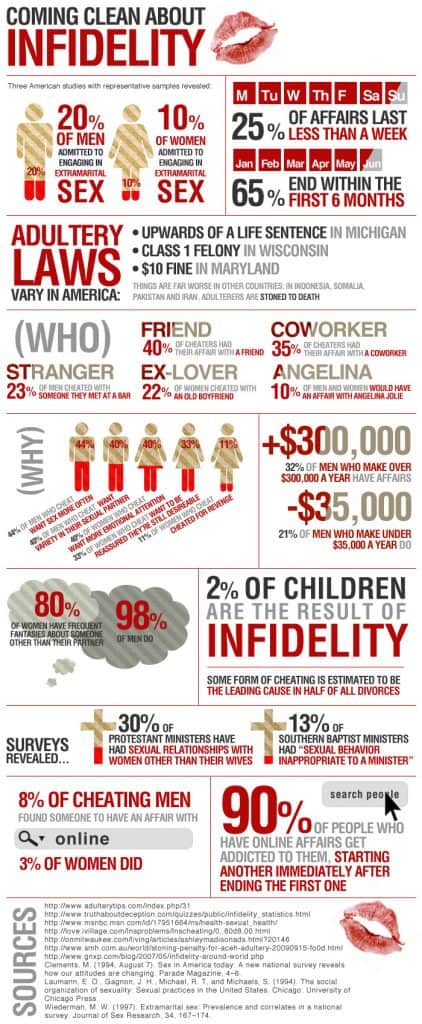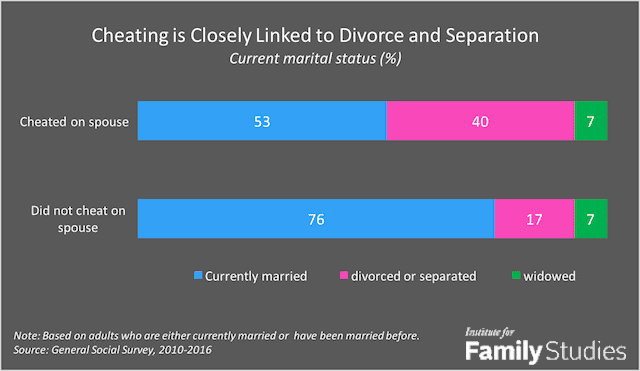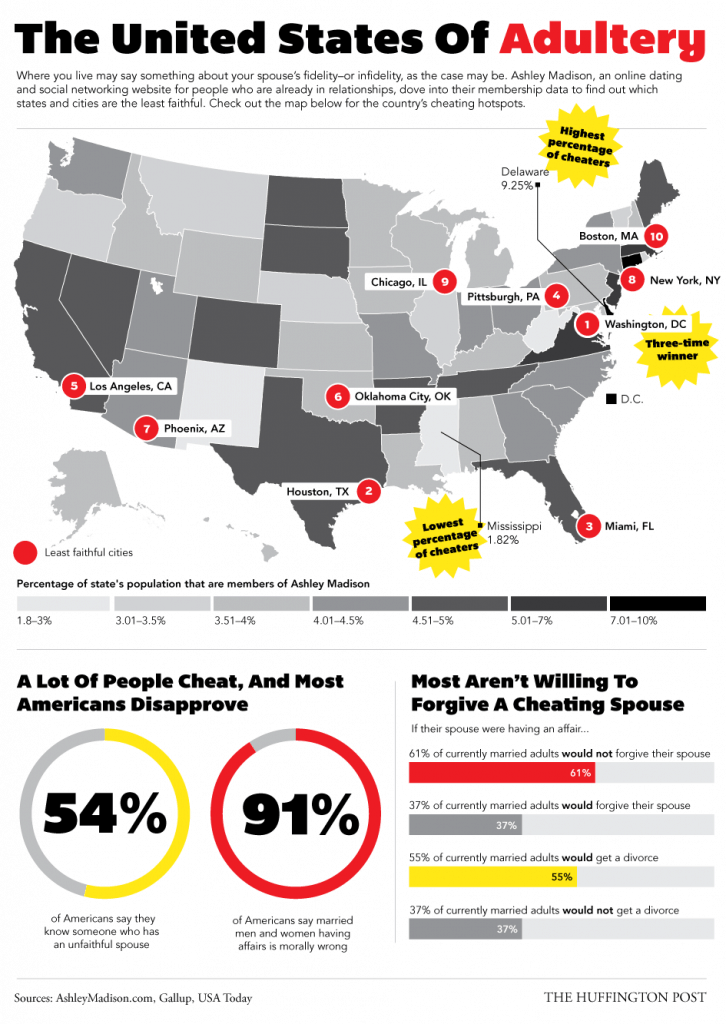Relationships are sometimes complicated.
Finding out that he’s cheating sucks big time.
I know it doesn’t make too much of a difference, but maybe it helps to know you’re not alone.
According to the infidelity statistics, about 40% of unmarried relationships and 25% of marriages see at least one incident of infidelity.
An issue of Marriage and Divorce journal also stated that 70% of all Americans engage in some kind of affair sometime during their marital life.
These numbers are simply astonishing and have more serious implications than you could imagine.
Indeed, if we were to look at the numbers, it’s safe to say cheating is the norm rather than the exception, and it may even lead us to question the whole monogamy thing.
For a clearer picture of things, let’s have an in-depth look at the latest infidelity statistics and trends.
Infidelity Statistics 2018 vs. 2019
Contents
Starting off our journey to the discovery of the infidelity statistics, let’s compare the differences between 2018 and 2019.
The truth is there isn’t much of a difference between the two years.
Both in 2018 and in 2019, men are more likely to cheat than women. According to recent data gathered from the General Social Survey, 20% of the interviewed men and 13% of women admitted they had sex with someone other than their spouse while married.
According to the same source, things didn’t change much in the past 20 years in terms of total cheats.
What the study found, though, is that infidelity amongst women increased by 40% in the last 20 years, while male infidelity rates remained steady, despite the number of cheating men still being higher than the number of cheating women.
According to researchers, the main reason people cheat is sexual dissatisfaction. However, this study doesn’t factor in online infidelity.
When accounting for the use of dating apps and online cheating, there tends to be a difference between 2018 and 2019.
Indeed, these apps make it easier to cheat without getting caught, and according to a study by YouGov, men are three times more likely than women to use dating apps and sites for casual sex.
The study also highlighted than one in six people who are using dating apps are using the apps to cheat on their partners.
Apparently, the millennials are more likely to cheat using a dating app, with 11% of the respondents confirming they are using dating apps to cheat on their partner.
Infidelity Demographics in the USA

While there seem to be little differences between 2018 and 2019, some demographic differences seem to exist.
Studying the infidelity demographics also comes in handy if you want to estimate the chances of being cheated on.
So, let’s have an in-depth look at the numbers.
Gender
For decades, men have been considered the greatest cheaters. They’ve topped the charts for cheating more than women since the dawn of time. However, recent data from a survey conducted by the National Opinion Research Center at the University of Chicago has indicated that gender patterns tend to change.
The gender gap is narrowing among younger adults, as 12.9% of the American women aged between 18 and 24 have cheated, compared to 15.9% of their male peers.
To understand the difference, the same study conducted on people aged 65 and older revealed that 25% of men have cheated, versus less than 10% of women.
The Institute for Family Studies confirms the NORC research and discloses that among millennials, women are more likely to cheat on their spouse while married. According to the report, 11% of the married women aged 18 to 29 are guilty of infidelity, while only 10% of their male counterparts have been cheating while married.
Race

A number of other demographic factors also speak volumes about the infidelity rates. For example, when it comes to race, black adults are more likely to cheat than all other races.
Indeed, the Institute for Family Studies confirms that about 22% of the ever-married blacks admitted having cheated on their spouse, compared to 16% of whites and 13% of Hispanics.
The rate is higher among black men, 28% of whom reported to have had sex with someone other than their spouse. By comparison, only 20% of the white men and 16% of the Hispanic men cheated on their spouse while married.
Age
Age is another demographic factor worth considering. As the figures above indicate, the gender gap between cheaters varies by age.
While women are more guilty of infidelity among the ever-married adults aged 18 to 29, the gap quickly reverses among people aged 30 to 34, and it tends to grow wider in older age groups.
Apart from this demographic consideration, you should also know that the infidelity rates for both men and women increase during their middle ages.
The highest peak of infidelity among men happens in the 51 to 59 age group, with 31% of respondents declaring that they have cheated. The interesting fact is that as time passed, the age shifted and showed that the higher rates of infidelity happened for men aged 60 to 69.
When it comes to women, the age trend follows the same pattern. Statistics from the 90s show that women aged 40 to 49 had the highest infidelity rates (18%), while in the following decade, the infidelity shifted to women aged between 50 and 59.
Elderly people don’t cheat quite as much as the younger ones, but the gender gap tends to be more evident.
From all respondents in their 70s and 80s, the infidelity rate among men was 26% and 24%, respectively, with a difference of 18% between men and women.
Education
For decades, it has been believed that those with higher education are less likely to cheat. However, the Institute for Family Studies claims the contrary.
Not only they are not less likely to cheat, but the institute has found no link between education and the chances of cheating.
According to their survey, almost equal shares of college-educated individuals and individuals with lower education have been unfaithful to their spouse, with a percentage of 16% vs. 15%.
However, the share is slightly higher among adults who have started college but didn’t finish it for one reason or another, as 18% of the respondents admitted to having cheated their spouse.
Political views
While cheating and politics don’t seem to have much in common, the truth is that political identity is also related to whether your partner is likely to cheat or not.
Overall, Democrats are more likely to cheat than the Republicans or the Independents, with the number showing us that 18% of those defining themselves as Democrats admitting to having cheated, compared to 14% and 15%, respectively.
Religion/beliefs
Religion – or, more specifically the faithfulness – also plays a role in determining the cheating behavior. While the study didn’t compare the cheating rates between people of different beliefs, it tells us that those who attend church once or less a year are more likely to be unfaithful to their spouse than those who attend mass several times a year or once a week.
Family background (divorced or non-divorced parents)
Your partner’s family background may also play a role in cheating. In fact, statistics show that those who grew up in intact families (with both biological or adoptive parents) are less likely to cheat than those whose parents divorced.
In terms of numbers, 18% of the respondents who didn’t grow up with both parents declared they have cheated on their spouse, compared to 15% of those who grew up with both parents.
How Many People Admit Infidelity?

The numbers of these surveys are clearly based on participants willing to admit their infidelity – either to the researchers or to their spouse.
According to a study conducted by Michigan State University, the average American lies at least two times a day. Over 60% of the respondents even affirmed they couldn’t go for more than 10 minutes without lying.
In other words, what are the chances that your partner or spouse will ever admit cheating?
The answer comes from the Health Testing Centers, which conducted a survey of 441 people. According to their results, the cheating rate among the respondents was 46.1%. From these, 47.9% admitted to having cheated but never admitted it to their partner, while the other 52.1% admitted it to their partner.
However, 76% of the cheaters admitted having cheated on their former partner in front of their new partner.
From those who decided to come clean in front of their partner, 47.7% did so in the first week, 26.6% in the first month, and 25.7% in six months or longer.
The reason for admitting cheating was guilt for 47% of the respondents, followed by the need to let their spouse know or the belief that their partner had the right to know.
Divorce Rates and Infidelity

Infidelity statistics about the divorce rate come both from the Institute for Family Studies and the Health Testing Center.
According to the former, 40% of the ever-married adults who have cheated on their spouses are divorced or separated. By comparison, only 17% of those who have been faithful to their spouse are divorced or separated.
There is also a significant gap among remarriage rates, with only about 50% of the cheaters being currently remarried, while 76% of the divorcees who never cheated being currently remarried.
Whether it’s due to the lack of remorse or gender behavior, there is also a gender gap between cheaters who remarried. Indeed, 61% of men married other women, while only 44% of the women who cheated married again.
The Health Testing Center investigated the outcomes of admitting to having cheated, and the results are conclusive.
Fifty-four point five percent of couples broke up immediately, and only 15.6% declared to still be together.
Among those who confessed cheating, 31.4% of men and 28.7% of women divorced immediately; the age gap is more significant for those who are still together, with men tending to be more forgiving. Indeed, 19.8% of the women who cheated are still together with their spouse, while only 10.3% of the men succeeded in saving their relationship.
From those who got their second chance, 61% of the married ones declared that their spouse implemented rules or consequences, while 47.5% of those who cheated on their partner in an unmarried relationship had the same fate.
Income and Infidelity Rates

Next, let’s investigate the correlation between income and infidelity rates. This is an important topic, as many people believe cheating is for the rich.
The truth is that those who are not extremely wealthy and famous, often don’t make the evening news when they cheat. Several studies conducted throughout America and Europe show, however, that people are equally likely to cheat regardless of their income, as long as they are in the workforce.
There is a strong correlation between cheating and economic independence, though.
Economic Independence vs. Infidelity
While the wage your partner earns has nothing to do with his chances of cheating, he might be more likely to cheat if he’s totally dependent on you.
Indeed, in a study published by the American Sociological Association, researcher Christin L. Munsch showed that among the heterosexual couples aged 18 to 32, spouses who earn significantly less than their partner have higher chances of committing adultery.
The gender gap is significant, though. According to the study, 15% of the men who were economically dependent on their wives committed adultery, while only 5% of the dependent women cheated on their husbands.
Things are different when earning a significantly smaller income was by choice. For instance, those who wanted to be stay-at-home moms or dads had the same risk of cheating as those earning as much as their partner.
Studies also showed that men who earn more than their partners are less likely to cheat if their income doesn’t exceed 70% of the total household income. If this threshold is surpassed, the chances of those men cheating on their wives increase exponentially.
Same-Sex Cheating Statistics for Hetero/Bisexual Couples

Homosexuality is far from uncommon, even in allegedly heterosexual individuals. According to research, 20% of women and 10% of men have felt attracted to same-sex individuals at least once in their lifetime.
Curiosity is a distinctive trait of human nature. Cheating on your spouse with a same-sex individual, therefore, isn’t exactly uncommon.
Participants in various studies published in the Evolutionary Psychology journal highlighted that 13.7% of the individuals were predominantly attracted by opposite-sex individuals, but didn’t exclude an affair with a same-sex individual, while 2.9% of the respondents were attracted by both sexes equally.
During the study, the participants were asked to rate their reaction to finding out that their partner has been cheating on them with same-sex partners.
The results highlight that men can be more comprehensive if their partner cheated on them with another woman. About 33% of the male respondents claimed they would tolerate this form of infidelity, whereas 22% of women declared the same thing.
When asked if they would prefer that their partner cheated on them with a same-sex partner or an opposite-sex partner, 76.4% of men said they would prefer their partner would cheat on them with another woman, while 62.2% of women claimed they would prefer that their partner would cheat on them with a woman rather than a man.
Sexual vs. Emotional Infidelity
When thinking about infidelity, most people imagine their partner under the sheets, living their best life with another man or woman. However, emotional infidelity is as popular as a sexual one – and it can often be more dangerous.
In a report for the Insider, Kristin Salaky even reports that in the age of the internet, emotional infidelity is becoming even more common than the sexual one.
To support this claim is a study conducted at the University of Wisconsin and published in Evolutionary Psychology. Researchers found that men and women have very different perceptions about the two types of infidelity, which each gender finding one more upsetting than the other.
Most men declared themselves to be more upset in case of sexual infidelity. In other words, your man would be very upset to find you in bed with someone else. However, 56% of men would find it more upsetting to find out that their partner has an emotional affair with someone else.
The trends stay the same among women, but there are many more women who would find it very upsetting if their partner would have an emotional affair. Indeed only 27% of women reported sexual infidelity as more upsetting, whereas 73% would be really pissed off to find out their man has an emotional affair with someone else.
Infidelity and Milestone Birthdays

In 2014, a group of researchers worked with Ashley Madison – the biggest dating site for people who are in relationships – to find if people have higher chances of infidelity when a milestone birthday approaches.
According to this study, people are more likely to cheat when a milestone birthday approaches, but not in the year of the milestone birthday.
To sustain this hypothesis are two studies conducted by the University of New York and the University of California that show people are more likely to have an extramarital affair during their 9-ending ages. In other words, both men and women are more likely to cheat when they are 29, 39, 49, etc.
By calculating the users on Ashley Madison, researchers found that 18% of these had their age ends in 9 compared to the other random-ending age of the other users.
While infidelity is quite hard to study in this way, these numbers suggest people do tend to have a “mid-life” crisis when approaching a milestone birthday.
Infidelity in Genetically Predisposed Individuals
Genetics plays an important role in determining our predisposition to a certain type of disease, for instance, and lately, it seems it may even play a role in determining how likely we are to cheat.
A study from the University of Queensland found that infidelity is more common among people who have specific types of vasopressin and oxytocin receptor genes. This might happen because vasopressin is a hormone related to sexual bonding, among others.
Whether this is the cause or not, the study is conclusive. As many as 62% of men and 40% of women possessing these genes have been found to commit adultery.
Infidelity in Younger vs. Older Americans

If researchers have known for decades that younger Americans are more likely to cheat on their partner than the older ones, the trend seems to have changed.
According to an analysis by the Institute for Family Studies found currently, Americans aged 55 or over are more likely to cheat on their spouses than those under the age of 55.
One-night-stands vs. Long-Term Cheating
When it comes to the average length of an extramarital affair, you should know that one-night-stands or short-term affairs are much more common than longer-term ones.
According to several studies, 25% of all affairs last less than one week, while 65% end in the first six months.
The remaining 10% usually turn into long-term affairs.
Recurrent Cheating Probabilities
There is an old saying that goes “once a cheater, always a cheater.” And most of the time, it turns to be just right.
I know you might be tempted to forgive him. But the truth is that he might cheat on you again without too many issues.
According to a study published in the journal Archives of Sexual Behavior, the individuals who have been unfaithful in a relationship were three times more likely to be unfaithful in their subsequent relationships too.
According to the same study, it also seems that those who have been cheated once are more likely to be cheated again. Indeed, participants who have reported being cheated on by their first partner were twice as likely to report being cheated by their second partner too.
Offline vs. Online Infidelity
But online infidelity goes way beyond finding someone to have a physical affair with.
There are video chat rooms, and cybersex tends to be a real trend in this age. Sexting is another way of cheating online.
The worst thing is that 90% of those who cheated online once developed cybersex addiction, starting a new affair as soon as another one ends.
Jobs Where People are Most Likely to Cheat
Another study by Ashley Madison shows that there really are professions that make you more prone to cheat. They are not the same for men and women, yet both genders were more likely to be infidel to their partner when practicing one of the nominated professions. Let’s see which they are.
Men vs. Women
Men working in these fields were more likely to cheat, according to Ashley Madison:
- Real estate and insurance: 3%
- Agriculture: 3%
- Legal: 4%
- Arts and entertainment: 4%
- Marketing and communication:
- Information and technology: 12%
- Trades: 29%
Women, on the other hand, were more likely to cheat if they worked in the following fields:
- Social work: 9%
- Education: 12%
- Finance: 9%
- Retail and hospitality: 9%
- Medical: 23%
Both men and women working in politics and the entrepreneurs of both genders had the same percentage of cheating, of 1% and 11%, respectively.
Main Causes of Infidelity

Several surveys also investigated what are the main causes of cheating. The reasons are very different between men and women, with 44% of men declaring they have been cheating on their partner because they wanted more sex. Another 40% of men cheated because they were looking for more sexual variety.
In other words, men are more likely to cheat because they are not sexually satisfied in their current relationship.
Women, on the other hand, are often looking for more emotional attention, with 40% of the respondents claiming this as their reason for cheating.
Another 33% declared cheating on their partner to find out if they were still desirable, while 11% of the interviewed women cheated as a form of revenge.
IQ and Cheating Rates
IQ also seems to have some relevance when calculating the probability of cheating. A study from 2010 found that men with higher IQs are less likely to be unfaithful to their wives. However, the study didn’t consider the personality of the participants and didn’t come up with clear statistics.
It is also important to notice that it’s only the men who are less likely to cheat. In fact, women with higher IQ have the same probability of cheating as women with lower intelligence.
Cheating with a Former Sweetheart
While there are little studies about people cheating their current partner with an ex, there are some studies that show that up to 44% of the people aged 17 to 24 get back to their ex after a breakup, and 53% of the respondents admitted having sex with their ex.
37% of couples living together and 23% of the married couples who have broken up also got back together again. This means there is a chance that your partner may cheat with an ex, especially at the beginning of your relationship.
Business Trips and Infidelity

Business trips and infidelity go hand in hand. After all, what better way to have an affair than when you’re away from home and with a more-than-plausible alibi.
Indeed, in a study by Gleeden that surveyed over 8,000 people, 62% of men and 57% of women declared they had an affair while on a business trip.
From the total of unfaithful individuals, 53% of men said they had an affair with a co-worker during the said business trips. Women tend to be more cautious, though, with only 27% engaging in affairs with co-workers.
Those who engaged in workplace affairs, also took their extramarital relationship to the office, with 24% of the interviewed men and 13% of women have done the deed at their place of work.
The Average Cost of Having an Affair
Now, whether you’re contemplating cheating or wondering how much your partner spends to cheat on you, perhaps you’d like to know how much having an affair costs.
According to VoucherCloud, a coupon site that surveyed how much Americans spend, the average affair costs about $2,664.
To come up with this amount, the company considered the answers of those who declared to have cheated on their partners to calculate the average hotel bills, dinners and drinks, gifts, date activities, and other expenses, coming to the conclusion that an average affair costs about $444 per month.
Considering that most affairs last for about six months, you’ll spend almost 3,000 grants to cheat on your partner.
But that’s not it. Getting caught can come with additional costs, such as a divorce attorney or couple therapy, which can easily take out of your pocket $15,000 or more.
Source link: millennialships.com

